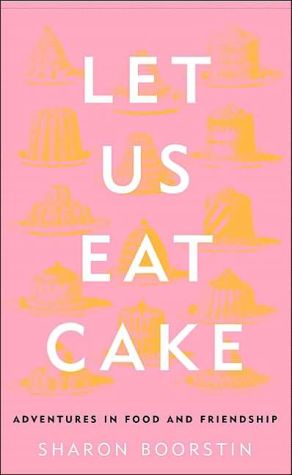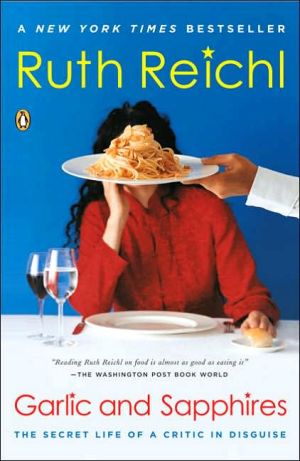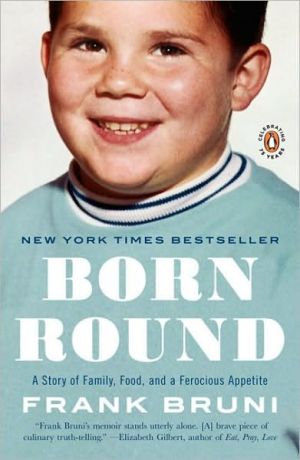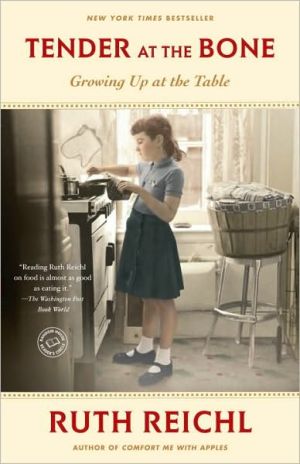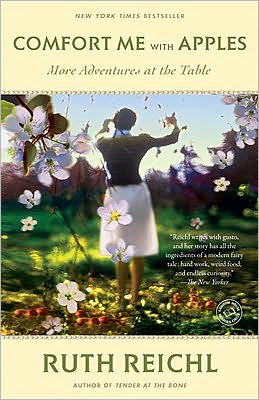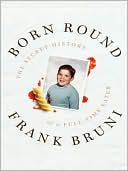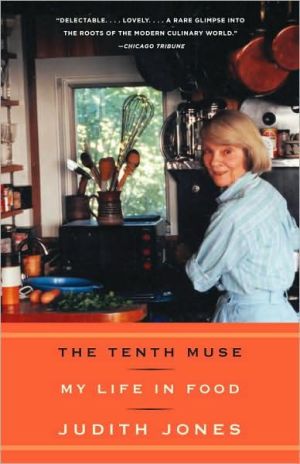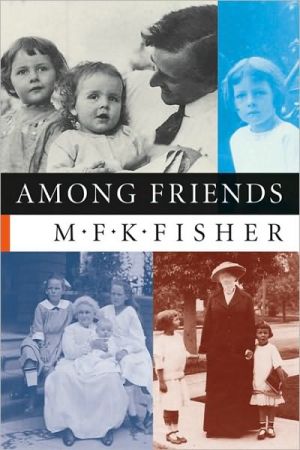Let Us Eat Cake: Adventures in Food and Friendship
Every woman has poignant food memories: the times she licked the bowl when her mother baked a cake, or helped her grandmother make blintzes, tortillas, or Southern fried chicken. And how about the times she and her girlfriends baked chocolate-chip cookies or, later, prepared elaborate dinners to impress potential husbands?\ One day when looking through an old desk she'd bought as a newlywed thirty years earlier, food writer and restaurant critic Sharon Boorstin discovered a notebook of...
Search in google:
Every woman has poignant food memories: the times she licked the bowl when her mother baked a cake, or helped her grandmother make blintzes, tortillas, or Southern fried chicken. And how about the times she and her girlfriends baked chocolate-chip cookies or, later, prepared elaborate dinners to impress potential husbands?One day when looking through an old desk she'd bought as a newlywed thirty years earlier, food writer and restaurant critic Sharon Boorstin discovered a notebook of recipes she'd collected from her mother, relatives, and girlfriends at the time. It inspired her to reconnect with the recipe givers — some of whom she hadn't seen in years — and to explore the power of cooking and food in establishing bonds among women. Let Us Eat Cake celebrates these connections. As a young girl, Boorstin helped her mother make tuna casseroles; on a college trip to Europe, she and her girlfriends compared men and restaurants with equal zest; after she became a food writer, Boorstin bonded with women in the food world including Barbara Lazaroff (Mrs. Wolfgang) Puck, the Too Hot Tamales, and Julia Child. Today, after decades of enjoying food and cooking together, Boorstin and the women in her life have come to understand what truly makes for female friendships.With dozens of delicious recipes and vintage photos, this moving book will inspire readers to remember and cherish their own experiences with food, family, and friends. Publishers Weekly Noted food writer Boorstin was cleaning out her desk one day when she came across a notebook of recipes she'd collected as a newlywed in the late 1960s. Each recipe brought back memories of the women who'd shared it with her and the friendships that resulted. Boorstin threads these recipes for dishes such as Mireille's Halibut in Champagne and Ina's Brownies through her memoir, tracing the evolution of her friendships with women through the years, from her 1950s suburban Seattle childhood (the "Age of Innocence and Frozen Marshmallows") to the days of "women's lib" and the psychotherapy-saturated '70s, when Boorstin marries, has a daughter and begins documenting the California restaurant revolution for magazines such as Bon App tit. Boorstin shares painful memories as well her sister's mental breakdown, her own broken engagement. As her daughter grows up and parental pressures ease, Boorstin begins to develop cherished relationships with women independent of her family. "When it comes right down to it," Boorstin writes, "a woman really is the sum of all the friends she has had in her life." The result is a charming homage to women's camaraderie. Although perhaps not as penetrating as M.F.K. Fisher's writings nor as sparkling as Laurie Colwin's, there are still treasures to be found in this likeable baby boomer memoir. (May) Copyright 2002 Cahners Business Information.
Chapter One\ The Fish Family"The most beautiful girl at Garfield" is how more than one man who knew my mother in high school described her. A gifted violinist as well as a beauty, with wavy black hair and a figure that made men's heads turn, Fannie Horowitz became the concert-mistress in the University of Washington orchestra, but she was too nervous when performing to pursue a career as a professional musician. At the age of twenty she stowed away her violin, married my father, and devoted herself to being Mrs. Robert E. Silver, the perfect housewife and, later, mother.\ My mother was a good cook and she was proud of what she made, but she didn't love cooking. Like most women of her generation, she cooked because it was, her responsibility in the family, like washing clothes or buying new saddle shoes for my two sisters and me before school started each fall. When I helped her cook for a special holiday dinner or a party, she didn't play opera, gossip, or discuss the meaning of life with me, the way I do today when I'm cooking with my daughter, Julia. My mother was all business in the kitchen, and she rarely followed a recipe. The only cookbook she owned — The Settlement Cookbook — collected dust on the shelf. She was a self-described shiterein cook — that's Yiddish for "she just threw stuff in."\ Somehow, my mother knew the correct number of onions to chop for the casseroles she threw together for weekday dinners, and the amount of sugar needed to sweeten the jam she made from the tart purple plums my sisters and I picked in our backyard. My mother called it jam, but since she didn't usepectin, it was runny, more like sauce. She liked it that way, I liked the chunks of plum I could fish out with a fork. Even though my mother's plum whatever didn't need to be frozen, she stored it in the freezer.\ In our house, just about every food that didn't come in a can — from Dungeness crab, legs to Milky Ways to marshmallows — was stashed in the freezer. The freezer also contained ice cream in big commercial cartons and oversized oatmeal-raisin cookies that were baked by my mother's brothers, Harry and Norman, who sold them wholesale.\ Other families made do with a freezer compartment at the top of their refrigerator. Ours was a twenty-cubic-foot Sears chest freezer that was neatly as big as our kitchen table and stood within arm's reach of it. The gleaming white treasure chest was a symbol of just how important a role food played in our household, a role that bordered on obsession. Perhaps it was because my mother and father grew up during the Depression, when their parents could barely put enough food on the table to feed their families. Or because my father was the vice president of a fish company and brought home canned tuna, salmon, and crab by the case. Whatever the reason, the thought and energy that other families focused on sports and hobbies, ours focused on food. Even the nickname my parents gave me had a food reference: not Sherry for Sharon, but Cherry.\ When the whim hit her, my mother would cook a big pot of borscht and store it in jars in the freezer. One summer, Dorothy, our teenage live-in baby-sitter, mistook a jar of frozen borscht for frozen plum sauce and baked what turned out to be a borscht pie. When the pie was baking, cabbage stink pervaded the house. Dorothy was embarrassed. She was just a farmer's daughter, she told my mother — what did she know?\ Dorothy had moved to Seattle from Montana so she could experience life in the big city. A thin brunette with freckles who looked like Veronica in the Archie comics, Dorothy traded baby-sitting and, light cleaning for a room in our basement. She wore bobby, pins to hold her spit curls in place, a thin gold ankle bracelet, and straight skirts that hit midcalf and were so tight that she had difficulty walking in them. I was around eight at the time, and, I dreamed of lookIng just like her when I was a teenager.\ My father helped Dorothy with her high school homework; she never would have graduated without him. He also kept her boyfriend, Vito, a James Dean wannabe with a ducktail, at bay. Vito was only allowed to come over when my parents were home, so he wasn't around the night our pet chicken was killed. It was just my two sisters, Dorothy, and me. As often happened at our house, food played a part in the story.\ My father, who had studied food chemistry in college, often tested new pet foods-by-products of his company's canned fish — on our pets. By pets I mean two German shepherds, a neurotic mother-and-son duo named Blickendorf and Wolfgang; a mutt named Lucky; and two cats who practical reasons we called Biggie and Littlie. Collectively, the pets were referred to as "the animals."\ My father would bring home cans of pet food marked x, y, and z and plunk them down in front of the animals. The can they favored became the next Kitty Cat Food or Happy Dog Food. Since my father made good use of our animals, I figured I might as well add a chicken to the brood. Especially since it was free.\ We lived on the outskirts of Seattle, so far out of town that when one car-pool mom drove kids home, she took all the others to their houses and then dropped me off at a bus stop. One benefit of living in the boonies, though, was that near our house were fields overgrown with wildflowers, stands of evergreen trees, and a smalI farm. My younger sister, Sheila, and I walked past the farm on our way home from elementary school.\ Let Us Eat Cake. Copyright © by Sharon Boorstin. Reprinted by permission of HarperCollins Publishers, Inc. All rights reserved. Available now wherever books are sold.
\ From Barnes & NobleThe Barnes & Noble Review\ Food as nourishment, food as love, and food as reflection of a changing sense of self: These are the themes that Sharon Boorstin explores in this baby-boomer memoir -- with recipes -- that celebrates the connection between food and friendship. (Think Ya-Ya Sisterhood, but younger, in the kitchen.) \ Sharon Boorstin grew up in Seattle in the '50s, raised on pot roasts, tuna casserole, and her grandmother's blintzes. By the time she had graduated from college in the '60s and recovered from a broken engagement, she and her best friend spent hours making fancy French food -- brandied stuffed chicken legs and French apple tart spiked with Calvados -- to impress their dates.\ Boorstin's early married years were the fondue years, with escargots bourguignonne as appetizer. By the time Boorstin became a teacher in an alternative school in the '70s, brown rice and salad greens were on the menu. Come the '80s, she found herself as a food writer at the epicenter of the food revolution in Los Angeles; Spago had just opened, and people thrilled to its pizzas and California cuisine.\ This memoir was inspired by Boorstin's discovering an old loose-leaf notebook that dated from the beginning of her marriage; it contained Irma's Tandoori Chicken, Aunt Hannah's Chocolate Cheesecake, and Mary Ann's Grapes Brulée. That prompted Boorstin to reflect on girlfriends from the different stages of her life: friends from childhood and newer friends met through the food profession, like Barbara Lazaroff of Spago, Susan Feniger and Mary Sue Milliken (the Two Hot Tamales), and Suzy (Born to Shop) Gershman.\ "When it comes right down to it, " concludes Boorstin, "a woman really is the sum of all the friends she has had in her life." Her book will strike a responsive chord with many readers, especially those who cook with their friends. (Ginger Curwen)\ \ \ \ \ \ Publishers WeeklyNoted food writer Boorstin was cleaning out her desk one day when she came across a notebook of recipes she'd collected as a newlywed in the late 1960s. Each recipe brought back memories of the women who'd shared it with her and the friendships that resulted. Boorstin threads these recipes for dishes such as Mireille's Halibut in Champagne and Ina's Brownies through her memoir, tracing the evolution of her friendships with women through the years, from her 1950s suburban Seattle childhood (the "Age of Innocence and Frozen Marshmallows") to the days of "women's lib" and the psychotherapy-saturated '70s, when Boorstin marries, has a daughter and begins documenting the California restaurant revolution for magazines such as Bon App tit. Boorstin shares painful memories as well her sister's mental breakdown, her own broken engagement. As her daughter grows up and parental pressures ease, Boorstin begins to develop cherished relationships with women independent of her family. "When it comes right down to it," Boorstin writes, "a woman really is the sum of all the friends she has had in her life." The result is a charming homage to women's camaraderie. Although perhaps not as penetrating as M.F.K. Fisher's writings nor as sparkling as Laurie Colwin's, there are still treasures to be found in this likeable baby boomer memoir. (May) Copyright 2002 Cahners Business Information.\ \ \ BooknewsBoorstin uses food as the central motif for this distinctly sweet-toned memoir. Annotation c. Book News, Inc., Portland, OR (booknews.com)\ \ \ \ \ Kirkus ReviewsA restaurant critic and food writer's engaging recollections: part memoir, part cookbook. Boorstin was clearing out an unused desk when she unearthed a notebook of 30-year-old recipes that recalled her youth and led her to examine cuisine connections among family and friends. She didn't just forage in her memory bank; she sought out and reconnected with friends from school days, as well as more recent acquaintances. The memories they share are often funny (mushrooms stuffed with marijuana, the snails that got away) and sometimes wistful, as divorce, sickness, and death play inescapable roles over three decades. Food professionals Boorstin encountered in the course of her work make cameo appearances and contribute recipes: Julia Child explains how to cook a lobster; Wolfgang Puck passes along his formula for matzoh; and Nell Newman reveals the makings of father Paul's favorite angel-food cake. Other recipes include avocado soup from London via Kenya, the perfect gazpacho from Spain, and a "husband-catcher cake" handed down for three generations (apparently it works). Especially winning are tales of her mother, who always kept a big chest freezer filled with frozen marshmallows, big oatmeal cookies, and Dungeness crab legs. (Dad was vice president of a Seattle fish company.) Mom was a good cook, but given to doctoring vegetables with Campbell's Cream of Mushroom soup (an icon of 1950s cuisine) and "all business" with Sharon in the kitchen. Boorstin made it a point to welcome her own daughter warmly into the kitchen, where they listened to opera, gossiped, and became friends as they cooked sans canned mushroom soup. "Women bond over food the way men do over sports," she concludes. Bonappetit to readers who agree with that rather sweeping statement; even those who don't will enjoy the cheerful anecdotes and the memorable dishes. (photos, not seen)\ \
